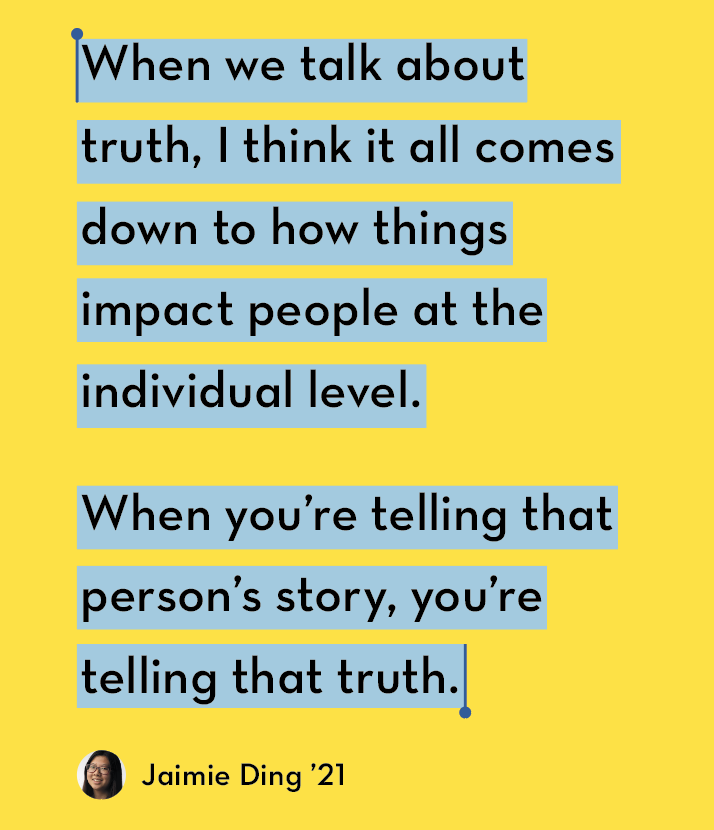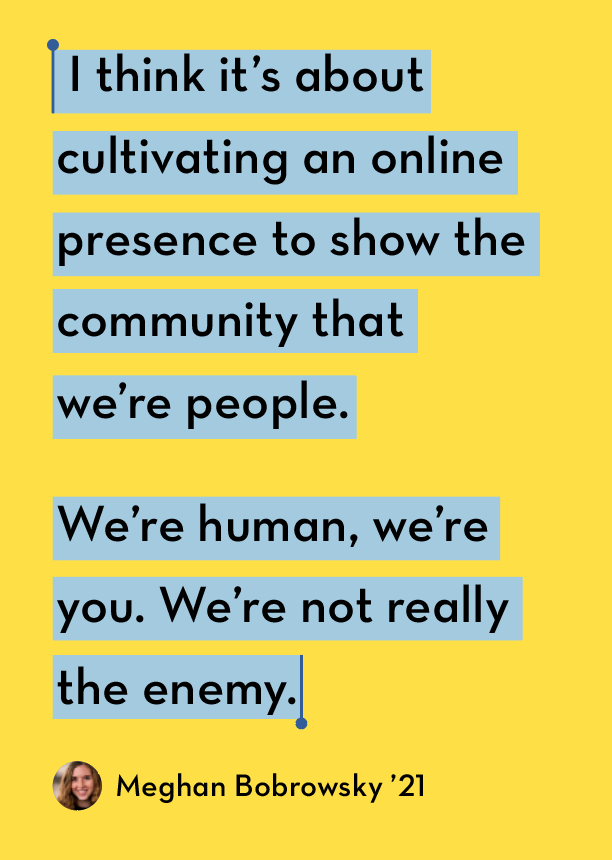By Rachael Warecki ’08

Earlier this year, the New Yorker published an article titled “Does Journalism Have a Future?” It’s an important question but an old one—the same thing I was asking myself in August 2007, at the end of my stint with the San Mateo Daily Journal. A month earlier, I’d covered the festivities surrounding the Major League Baseball All-Star Game in San Francisco; a month later, I would return to Scripps and take over as the Voice’s editor-in-chief. If I wanted to continue in the field after graduation, I was well positioned to do so.
Instead, I became a teacher. I’d dreamed of being a sportswriter ever since I’d realized that newspapers would pay me to write about something I loved, but in 2007, the idea that I’d be able to live on that pay for the length of a career was laughable. Although few people had smartphones in their pockets, readers were buying fewer print papers. It would be another decade before the president of the United States used Twitter to call the press the “enemy of the American people,” but blogs and social media platforms were already taking off as alternative sources for news. I recognized that the internet was starting to disrupt—to use a favorite Silicon Valley buzzword—the journalism field. But I didn’t anticipate how much disruption it would create.
In 2008, when I left the newsroom for the classroom, concerns about journalism were mostly economic: conglomeration, the expectation of free online content, and the recession’s decimation of publishers’ budgets. When I made the jump to public relations in 2012, the focus was on online news aggregators, Twitter mobs, and new, digital-driven forms of citizen journalism. Now we’re having a national conversation about deliberate disinformation campaigns, massive media layoffs, and the question of whether the press can be trusted to report objectively—and whether the public can be trusted to believe those reports. These are also questions that Scripps students and alumnae are working to answer as they navigate these shifts in journalism and other information fields.
Poppy MacDonald ’97 is the publisher of USAFacts, a nonpartisan website that provides data on government revenues, spending, and outcomes without using projections. She hopes that publishing the facts—and only the facts, sourced from government agencies—will establish a common ground for objective public policy discussions.
“We’re showing you that this is the data, this is the historical context of how it’s changed over time in the U.S., this is how it’s affecting different demographics, and this is how the lives of Americans are changing,” she says. “All we’re asking is that people on both sides of the aisle start with agreement on the facts.”
However, Michelle No ’12, who writes articles on food, travel, and identity for BuzzFeed, says that facts and objective reporting aren’t always enough for the newest generation of readers, who’ve grown up navigating influencer culture. “Anyone younger than 25 is so used to having so much information available that they want to go one step further,” she says. “They know what’s fake. They want details and authenticity.” When No seeks to prove or debunk cooking hacks, for example, she includes photos and videos taken at home, avoiding footage that appears too glossy or practiced.
What authenticity means, though, is what is up for debate. And in an era of “deepfake” videos, virtual-reality digital influencers, sponsored content, and biased and noncredible news outlets, is it even attainable? The situation is dire enough, according to former Guardian editor-in-chief Alan Rusbridger, that “we are, for the first time in modern history, facing the prospect of how societies would exist without reliable news.” The fact is, the digital media landscape continues to change journalism more than a decade after I first wondered whether the internet would dismantle it. And along the way, it’s changing the way we view the truth.
Since my days in the newsroom, the definition of truth has become more expansive—in some ways for the better. Social media has created spaces for members of underrepresented communities to find each other, tell untold stories, and correct a historical record that has frequently disregarded people from marginalized backgrounds. To a certain extent, it has also democratized access to media careers. For example, No doesn’t have formal training in journalism or the culinary arts; instead, she parlayed freelance work and a passion for writing into a series of jobs at high-profile media companies. Since then, she’s seen Twitter users employ their platforms to start important conversations with traditional media outlets. “When something goes viral, any mainstream media publication is forced to talk about it,” she says.
For Meghan Bobrowsky ’21 and Jaimie Ding ’21, who both write for the 5C newspaper The Student Life and interned at The Sacramento Bee this summer, truth telling in today’s media landscape is about holding people in power accountable. Bobrowsky, like MacDonald, believes that providing access to data—especially financial data—is key to bringing truth to the public. It’s a lesson she brought to The Bee from her politics classes at Scripps and from her journalism experience in high school, where her investigative series on her school district’s budget earned her National High School Journalist of the Year honors from the Journalism Education Association.
Ding, who’s also studying politics, believes in focusing on individual experiences. “When we talk about truth, I think it all comes down to how things impact people at the individual level,” she says. “When you’re telling that person’s story, you’re telling that truth.”
The flip side of this inclusivity is the false notion that if everyone is telling “their truth,” then no one is ever lying—that internet charlatans are as reputable as fact-checked journalists, as long as the charlatans hold their opinions strongly and express them loudly enough. Over the past five years, this idea has allowed internet forums like Reddit, alt-right outlets, and, most notably, members of the executive branch to promote widespread but disproven stories under the guise of “alternative facts.” However, mainstream news organizations have been reluctant to label these stories as outright lies, due to the question
of intent. They question: Does the president know he’s spreading false information, or is he merely stating his personal truth?
To a public frustrated with perceived political pussyfooting, this semantic reluctance has eroded trust in the media. It’s an erosion that’s stretched beyond journalism to encompass public relations and customer service, as well. In another previous role as a social media professional, I fielded aggressive Twitter interactions, personal threats through direct messages, and profanity-laced phone calls—all because my company’s name change had become a top Facebook news story, thanks to an outraged, inaccurate far-right news article and some social media algorithms. (The prevailing, very incorrect theory among furious commenters: we’d changed our name from that of a departed movie star and USO performer because we, as Californians, hated patriotic “real Americans.” Repeatedly explaining that we’d changed it to improve our geographic identity did not minimize these commenters’ convictions.)
When the term “fake news” first entered our lexicon, many journalists thought the label best applied to these types of online conspiracy theories, invented from whole cloth and spread to credulous audiences via the internet. MacDonald even anticipated that fake news allegations would be a boon for trusted media brands; she expected that people who usually got their news from users on social platforms like Twitter would turn instead to mainstream publications.
But then President Trump leveled his fake news charge at the mainstream media. MacDonald, who was working for POLITICO at the time, said the accusations added new challenges not just for reporters but for the business side of publications as well. The newsroom’s editorial ambitions and increased attention to detail came with increased costs. “We double- and triple-checked everything,” MacDonald says.
Although the administration continues to lob accusations of fake news at the mainstream press, MacDonald believes there’s still hope for public trust in journalism. A 2018 USAFacts poll showed that over the course of a year, Americans became 14 percent more likely to believe that using a different set of facts causes more problems in the U.S. than holding different political beliefs. In 2017, there was an eight percent gap between the two beliefs; in 2018, that gap widened to 22 percentage points.
All four of the journalists and publishers I interviewed agree that media transparency is key to regaining public trust. It’s a goal toward which many outlets are already working. Many newspapers have started to explain how their stories are reported. Longform investigative articles now include sidebar summaries of the methods used, the people contacted, and the documents reviewed while building the story.
MacDonald emphasizes USAFacts’ charts, graphs, and simple data presentation. “I think the investment we’re making in bringing the facts to the people, making them easy to understand, easy to search—we’re headed in the right direction.”
Bobrowsky, Ding, and No also agree that social media, for better or worse, will continue to shape the field. Publications will have to adapt their strategies for an increasingly digital world. BuzzFeed introduces itself to new hires as a tech company, and it prioritizes a website content management system that allows its writers to publish posts quickly. To attract readers from Generation Z—a demographic more likely to watch a clip than read an article—other outlets are pivoting to video to tell their stories.
And yet, with as much disruption as social media has wreaked on journalism, Bobrowsky believes that it will play an important part in countering the narrative of the media as public enemy number one. At The Bee, she’s reported breaking news through the paper’s Facebook Live stream, responding to viewers’ questions in real time and putting a face to the byline. She also created an account on TikTok, a short-form video platform popular with younger audiences. The paper’s first TikTok featured its stuffed mascot (a bee, natch) in various newsroom poses, set to the Black Eyed Peas’ “Imma Be.” Bobrowsky says it showed viewers that the paper has a playful side.
“I think it’s about cultivating an online presence to show the community that we’re people,” she says. “We’re human, we’re you. We’re not really the enemy.”
So does journalism have a future? I believe it does. At Scripps, where I currently serve as a staff advisor for the Voice and liaise with reporters from The Student Life, students’ desire to provide readers with information and diverse perspectives is as strong as ever. The medium of reporting has become drastically different since my days in the newsroom—in some cases, more like the content I produced as a social media manager than as a journalist. But the students I’ve talked to are embracing these changes. Both Bobrowsky and Ding have spent the summer learning the basics of graphic design and data analysis to improve their marketability.
That capacity to adapt is a vital one in a field that’s continually evolving—and it’s one of the reasons I’m excited, rather than skeptical, about the future of journalism. Like generations of reporters before them, today’s young journalists recognize the importance of thorough research, the ability to listen as well as to ask good questions, the value of examining their own assumptions, and the need for transparency in reporting. But they’re also digitally savvy, wary of online manipulation tactics, and eager to tackle the media landscape’s new challenges. They see our current era not as the end of journalism but as a reinvention.
Their optimism is why I believe that, as long as we maintain freedom of the press, journalism will have a future. And that’s one thing—amid all the field’s changes—that I hope will stay the same.


